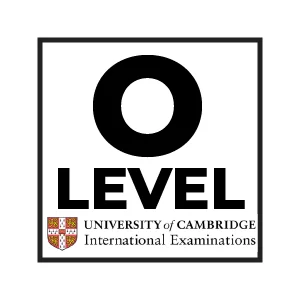The Cambridge O Level uses a 9 to 1 grading scale, where 9 is the highest achievable grade and 1 is the lowest. It replaced the previous A* to G scale. Grade 9 represents exceptional performance, while grades 7-8 denote strong performance, and grades 4-6 indicate satisfactory performance.
Grades 1-3 are considered below satisfactory. The system aims to provide clear and transparent assessment of student achievement in various subjects. It helps students, educators, and institutions understand and compare performance levels.
This grading system supports fair and consistent evaluation practices, ensuring that students receive recognition for their efforts and achievements.
What is O Level?
O Level, or ‘Ordinary Level,’ is a qualification for students in the UK and former British colonies, taken typically during adolescence.
It represents a standard of education usually achieved by students aged 14 to 16, typically at the end of their secondary schooling. O Level qualifications cover a wide range of subjects, including languages, sciences, humanities, and vocational subjects.
Historically, O Levels were based on the General Certificate of Education (GCE) system, which featured examinations set and marked by independent examination boards. However, in some regions, O Levels have been replaced by newer qualifications such as the General Certificate of Secondary Education (GCSE).
Despite this, the O Level qualification remains widely recognized and respected, particularly in countries where it is still administered.
Behind the O Level Grading Curtain

The O Level grading process is a meticulous one, ensuring fairness and consistency in student evaluation. Here’s a peek behind the curtain:
The Journey of a Script
Students diligently complete their O Level exams. Scripts are carefully anonymized to eliminate bias during marking. Security measures ensure papers reach the designated marking centers.
Standardization and Moderation
A team of experienced senior examiners marks a sample set of scripts for each subject. This sets the benchmark for consistent grading across all markers. Junior examiners are trained to align their marking style with the established standards.
Marking Process
Each script receives individual attention from a qualified examiner.
Examiners meticulously assess each answer based on pre-defined marking schemes and assessment objectives. For some subjects or in case of discrepancies, scripts might undergo double marking with final agreement from senior examiners.
Standardization Checks:
Senior examiners monitor the marking process to ensure consistency between different markers. If double marking is employed, the second marker wouldn’t be aware of the first marker’s score.
Awarding Marks:
Examiners award marks based on the marking schemes, resulting in a raw score for each script.
Grade Thresholds:
A statistical analysis is conducted on the overall performance of all candidates in each subject. Based on this analysis, grade thresholds (minimum marks required for each grade) are established. These thresholds ensure a consistent standard across different exam series and years.
Final Grades
Individual raw scores are compared against the established grade thresholds to determine the final letter grade for each student. Senior examiners might review borderline cases for final confirmation.
Result Release
Once finalized, grades are uploaded to a secure online system. Students officially receive their O Level results through their schools or exam centers.
Overview of the Cambridge O Level Grading System
The Cambridge O Level grading system evaluates students’ performance in the Cambridge O Level examinations. These are internationally recognized qualifications administered by Cambridge Assessment International Education (CAIE). Here’s an overview of how the grading system works:
Grading Scale
The Cambridge O Level grading system uses a scale from A* to G. A* is the highest achievable grade, while G is the lowest passing grade. Grades A* to C are generally considered passing grades.
Percentage Equivalent
Each grade corresponds to a specific percentage range. The typical percentage equivalents for each grade are as follows:
- A*: 90% and above
- A: 80-89%
- B: 70-79%
- C: 60-69%
- D: 50-59%
- E: 40-49%
- G: Below 40% (Not a passing grade)
Grade Thresholds
CAIE sets grade thresholds for each subject and examination series. These thresholds represent the minimum marks required to achieve a particular grade. The thresholds may vary from one series to another depending on factors such as the difficulty level of the examination papers.
Uniform Mark Scale (UMS)
Some examination boards, including CAIE, use a Uniform Mark Scale (UMS) to standardize grades across different examination series. UMS scores are calculated based on the raw marks obtained by students in their examinations.
Component Grades
In certain subjects, students receive separate grades for different components of the examination, such as coursework, practical assessments, and written exams. These component grades are combined to calculate the overall grade for the subject.
Recognition
Cambridge O Level qualifications are widely recognized by universities, employers, and governments worldwide. They play a significant role in facilitating students’ progression to further education or employment opportunities.
Grade Descriptors
CAIE provides grade descriptors for each subject, outlining the skills, knowledge, and understanding required to achieve each grade. These descriptors help students and teachers understand the expectations associated with each grade.
What is considered a good O Level result?

In general, what is considered a “good” O Level result can vary depending on individual circumstances and goals. However, for many students, achieving grades A* to C is often regarded as a good result. Here’s a breakdown:
| Grade | Percentage Range |
| A* | 90% and above |
| A | 80-89% |
| B | 70-79% |
| C | 60-69% |
| D | 50-59% |
| E | 40-49% |
| U | 0-40% |
*A (90% and above)**
This is an exceptional achievement and is typically seen as excellent. It demonstrates a high level of understanding and mastery of the subject matter.
A (80-89%)
This grade is also considered excellent and indicates a strong performance. It shows a solid understanding of the subject and often opens doors to further academic opportunities.
B (70-79%)
A grade of B is still considered good and reflects a solid performance. While it may not be as exceptional as an A or A*, it still demonstrates a good grasp of the subject material.
C (60-69%)
This grade is generally considered satisfactory and is often accepted as a passing grade for many purposes. It indicates a decent understanding of the subject but may leave room for improvement in certain areas.
D (50-59%)
While a grade of D is technically a passing grade, it may be seen as somewhat below average. However, it still signifies some level of understanding of the subject matter.
FAQ’s
What is considered a good O Level result?
A good O Level result is usually an A* (90% or above) or A grade (80-89%), representing excellent academic performance.
Final Words
The Cambridge O Level grading system is like a ladder. Grade 9 represents the top rung for outstanding performance, while grade 1 is at the bottom, indicating a need for improvement. It helps students see how well they’re doing in different subjects.
Further, teachers and schools also use it to understand students’ strengths and areas they can help with. By using this system, everyone can be sure that students get fair recognition for their hard work. It’s like a guide that helps students climb higher in their learning journey.
